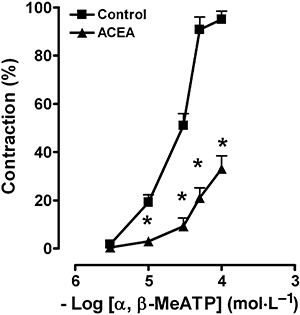Interaction between cannabinoid CB1 receptors and endogenous ATP in the control of spontaneous mechanical activity in mouse ileum
- PMID: 19466981
- PMCID: PMC2795265
- DOI: 10.1111/j.1476-5381.2009.00260.x
Interaction between cannabinoid CB1 receptors and endogenous ATP in the control of spontaneous mechanical activity in mouse ileum
Abstract
Background and purpose: Although it is well accepted that cannabinoids modulate intestinal motility by reducing cholinergic neurotransmission mediated by CB(1) receptors, it is not known whether the endocannabinoids are involved in more complex circuits and if they interact with other systems. The aim of the present study was to examine possible interactions between cannabinoid CB(1) receptors and purines in the control of spontaneous contractility of longitudinal muscle in mouse ileum.
Experimental approach: The mechanical activity of longitudinally oriented ileal segments from mice was recorded as isometric contractions.
Key results: The selective CB(1) receptor agonist, N-(2-chloroethyl)5,8,11,14-eicosaetraenamide (ACEA) reduced, concentration dependently, spontaneous contractions in mouse ileum. This effect was almost abolished by tetrodotoxin (TTX) or atropine. Inhibition by ACEA was not affected by theophylline (P1 receptor antagonist) or by P2Y receptor desensitization with adenosine 5'[beta-thio]diphosphate trilithium salt, but was significantly reversed by pyridoxal phosphate-6-azo(benzene-2,4-disulphonic acid) (P2 receptor antagonist), by P2X receptor desensitization with alpha,beta-methyleneadenosine 5'-triphosphate lithium salt (alpha,beta-MeATP) or by 8,8'-[carbonylbis(imino-4,1-phenylenecarbonylimino-4,1-phenylenecarbonylimino) bis(1,3,5-naphthalenetrisulphonic acid)] (P2X receptor antagonist). Contractile responses to alpha,beta-MeATP (P2X receptor agonist) were virtually abolished by TTX or atropine, suggesting that they were mediated by acetylcholine released from neurones, and significantly reduced by ACEA.
Conclusion and implications: In mouse ileum, activation of CB(1) receptors, apart from reducing acetylcholine release from cholinergic nerves, was able to modulate negatively, endogenous purinergic effects, mediated by P2X receptors, on cholinergic neurons. Our study provides evidence for a role of cannabinoids in the modulation of interneuronal purinergic transmission.
Figures










Similar articles
-
Cannabinoid CB(1) receptor activation modulates spontaneous contractile activity in mouse ileal longitudinal muscle.Eur J Pharmacol. 2008 Mar 17;582(1-3):132-8. doi: 10.1016/j.ejphar.2007.12.016. Epub 2007 Dec 27. Eur J Pharmacol. 2008. PMID: 18234188
-
Evidence for a modulatory role of cannabinoids on the excitatory NANC neurotransmission in mouse colon.Pharmacol Res. 2007 Aug;56(2):132-9. doi: 10.1016/j.phrs.2007.04.019. Epub 2007 May 10. Pharmacol Res. 2007. PMID: 17574859
-
Involvement of CB1 and CB2 receptors in the modulation of cholinergic neurotransmission in mouse gastric preparations.Pharmacol Res. 2007 Sep;56(3):185-92. doi: 10.1016/j.phrs.2007.06.002. Epub 2007 Jun 21. Pharmacol Res. 2007. PMID: 17656103
-
P2 receptors in the murine gastrointestinal tract.Neuropharmacology. 2002 Dec;43(8):1313-23. doi: 10.1016/s0028-3908(02)00294-0. Neuropharmacology. 2002. PMID: 12527481
-
Cannabinoids and the gastrointestinal tract.Gut. 2001 Jun;48(6):859-67. doi: 10.1136/gut.48.6.859. Gut. 2001. PMID: 11358910 Free PMC article. Review.
Cited by
-
Endocannabinoids in the Gut.Cannabis Cannabinoid Res. 2016 Feb;1(1):67-77. doi: 10.1089/can.2016.0001. Epub 2016 Feb 24. Cannabis Cannabinoid Res. 2016. PMID: 27413788 Free PMC article.
-
Guanosine negatively modulates the gastric motor function in mouse.Purinergic Signal. 2013 Dec;9(4):655-61. doi: 10.1007/s11302-013-9378-z. Epub 2013 Jul 10. Purinergic Signal. 2013. PMID: 23839776 Free PMC article.
-
Adenosine negatively regulates duodenal motility in mice: role of A(1) and A(2A) receptors.Br J Pharmacol. 2011 Nov;164(6):1580-9. doi: 10.1111/j.1476-5381.2011.01498.x. Br J Pharmacol. 2011. PMID: 21615720 Free PMC article.
-
Inhibitory effect of cannabichromene, a major non-psychotropic cannabinoid extracted from Cannabis sativa, on inflammation-induced hypermotility in mice.Br J Pharmacol. 2012 Jun;166(4):1444-60. doi: 10.1111/j.1476-5381.2012.01879.x. Br J Pharmacol. 2012. PMID: 22300105 Free PMC article.
-
GPCR theme editorial.Br J Pharmacol. 2009 Sep;158(1):1-4. doi: 10.1111/j.1476-5381.2009.00422.x. Br J Pharmacol. 2009. PMID: 19719776 Free PMC article.
References
-
- Abbracchio MP, Burnstock G. Purinoceptors: are there families of P2X and P2Y purinoceptors? Pharmacol Ther. 1994;64:445–475. - PubMed
-
- Baldassano S, Serio R, Mulè F. Cannabinoid CB1 receptor activation modulates spontaneous contractile activity in mouse ileal longitudinal muscle. Eur J Pharmacol. 2008;582:132–138. - PubMed
-
- Begg M, Molleman A, Parson M. Modulation of the release of endogenous γ-aminobutyric acid by cannabinoids in the guinea-pig ileum. Eur J Pharmacol. 2002b;434:87–94. - PubMed
Publication types
MeSH terms
Substances
LinkOut - more resources
Full Text Sources
Miscellaneous

